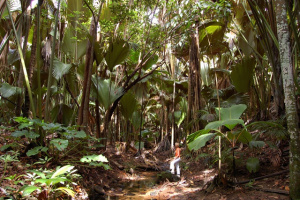Coco de mer census on Seychelles' Praslin Island shows stable and growing population
Research |Author: Rita Joubert-Lawen Edited by: Betymie Bonnelame | June 27, 2024, Thursday @ 09:00| 44400 views
Constance said that in terms of density there are 123 coco de mer trees per hectare in Vallee de Mai. (Gerard Larose)
The latest census by the Seychelles Islands Foundation (SIF) shows that the coco de mer population on Praslin, the second most populated island, is increasing and stable.
The SIF's science coordinator, Dr Annabelle Constance, revealed the findings of the study during a recent press conference.
The study, funded under the Frank Linear project, included Vallee de Mai, a UNESCO World Heritage site, and Fond Ferdinand and Fond Peper, all reserves managed by SIF.
In September 2020, SIF assumed the responsibility for Fond Ferdinand and extended its conservation mandate to one of Praslin's and Seychelles' most cherished protected areas. The Fond Ferdinand Reserve located at Grand Anse Praslin opened in 2013 and covers 122 hectares of land which is six times larger than the Vallee de Mai.
The three areas together account for around 55 percent of the coco de mer in Seychelles and in the world.
 |
| Fond Ferdinand covers 122 hectares of land which is six times bigger than the Vallee de Mai. (Seychelles Nation) Photo License: CC-BY |
"The results are very encouraging and in all the areas we have studied, we found that there tend to be more male trees of the species than female," said Constance.
The coco de mer, listed as an endangered species by the International Union for Conservation of Nature (IUCN), is a dioecious plant meaning its reproductive male and female parts are found on separate plants.
"Comparing the 2023-2024 study results to those held in the past, shows a stable and growing population which means that our conservation efforts are working, although there always remains room for improvement," she added.
The Vallee de Mai remains the area with the most coco de mer of all three studied, with 800 female, 966 male and 629 immature trees. Immature coco de mer trees are those close to reproduction age, but their genders are yet to be determined.
The study also shows the difference in population density of the coco de mer trees. Fond Ferdinand has 45 trees per hectare while Fond Peper has 15 trees per hectare.
"In terms of density there are 123 coco de mer trees per hectare in Vallee de Mai which is very impressive," said Constance.
There were 5,791 coco de mer trees counted in the census and the finding shows that the female trees bore an average of six mature nuts - with the exception being a record-breaking 56.
The latest census also recorded the height of the trees and immature trees tended to be shorter than mature ones, measuring 2.5 metres compared to matured females trees at 7.4 metres.
The coco de mer is the world's largest nut and is endemic to Seychelles, a group of 115 islands in the western Indian Ocean. It grows naturally only on two of Seychelles' islands, Praslin, and its neighbouring Curieuse Island, in terrestrial and marine parks.
Back
